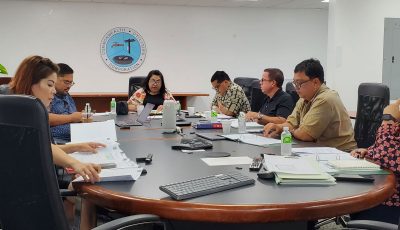US EPA TO CUC, BECQ:
‘Over $1.4M in labor costs charged to grants unsupportable’
EPA also slams regional office for lack of proper oversight
The U.S. Environmental Protection Agency’s inspector general has found that labor charging practices for the grants received by the Commonwealth Utilities Corp. and Division of Environmental Quality do not comply with federal grant requirements.
The inspector general, in a report released on Monday, recommends that EPA Region 9 disallow and recover over $1.4 million in “unsupported” labor costs.
It also slams the Region 9 officer for not providing adequate instruction to these local agencies and says their oversight was inconsistent over grants.
The inspector general called for improvements to in-kind and interagency agreement expenditure reporting and improving maintenance of Region 9 project officer files, which it says are not readily available to third parties.
The audit findings center on EPA “consolidate cooperative agreement, or CCAs, awarded to the DEQ and CUC for fiscal year 2014 and prior.
On issues with labor-charges, EPA questions some $1.08 in unallowable labor and fringe benefit costs, and for CUC questions some $402,000 in unallowable labor and fringe benefit costs.
EPA says DEQ’s charges were unallowable due to inadequate support and inadequate allocations of labor costs among multiple funding sources.
For CUC, labor and fringe benefits were unallowable due to the use of estimated allocations instead of “actual activities performed.”
“DEQ staff believed they had corrected problems with labor charging practices by discontinuing timecards and implanting a labor distribution system. CUC staff believes their use of estimates was acceptable based on the Region 9 project officer’s approval,” EPA said.
But they explained, citing federal requirements, that when employees work on multiple grant activities their salaries must be distributed and supported by personnel activity reports, which the employees must sign.
Also, labor charges are to be based upon an after-the-fact distribution of actual activity and not on budgets.
EPA says DEQ’s opting out of the use of timecards was an improvement but “it still did not capture all funding sources for allocation purposes.”
The agency says the new system did not include a grant award and therefore fiscal year 2014 charges were unallowable.
CUC labor charges
The EPA, pointing to the utility’s accounting records, said CUC charged labor costs to the CCA based on estimated percentage of labor ranging from 65 to 90 percent of the employees salary.
These includes its grant officer, grant specialist, and chief engineer.
Although CUC has multiple sources of funding, these employees do no allocate their time by pay period among different cost objectives or funding sources, EPA said.
Instead, estimates are set in advance for a six-month timeframe.
“And there is no reconciliation by employees to actual activity,” EPA said.
At the end of the six-month cycle, CUC’s executive director signs a verification of hours worked.
Federal requirements demand that if employees work on multiple activities or cost objectives, distribution of wages and salaries must be supported by personnel activity reports, among others.
Such documents would be reviewed when employees work on more than one federal award.
Budget estimates or other distribution percentages determined before services do not qualify as support, EPA said.
Inconsistent terms
The EPA also said that DEQ and CUC have inconsistent terms and conditions on agreement payment requirements for recipients to follow.
Region 9 oversight over CCA payments is also not consistent, EPA said.
Region 9 included some reimbursement terms in the agreements by placing an extra measure of control over recipient funds by requiring the recipient to submit draw requests to the EPA project officer for review and approval prior to payment.
“However, this extra measure of control was never completely implemented,” EPA said. “Consequently, there was confusion among DEQ, CUC and Region 9 staff about how agreement payments were to be made and whether the reimbursement method of payment was required.”
Possible $1.8M misreported
The EPA said they identified inconsistencies in reporting on in-kind and interagency agreement costs by DEQ in federal financial reports.
Federal regulations and the CCA grants require accurate reporting of outlays in these financial reports, EPA said.
However, Region 9 did not provide adequate instructions to DEQ on reporting requirements for in-kind and IA costs.
Specifically, Region 9 did not provide DEQ with procedures on how to obtain EPA-expended in-kind and IA cost data, EPA said.
“As a result, over $1.8 million of in-kind and IA costs may have been misreported by DEQ,” EPA said.



























